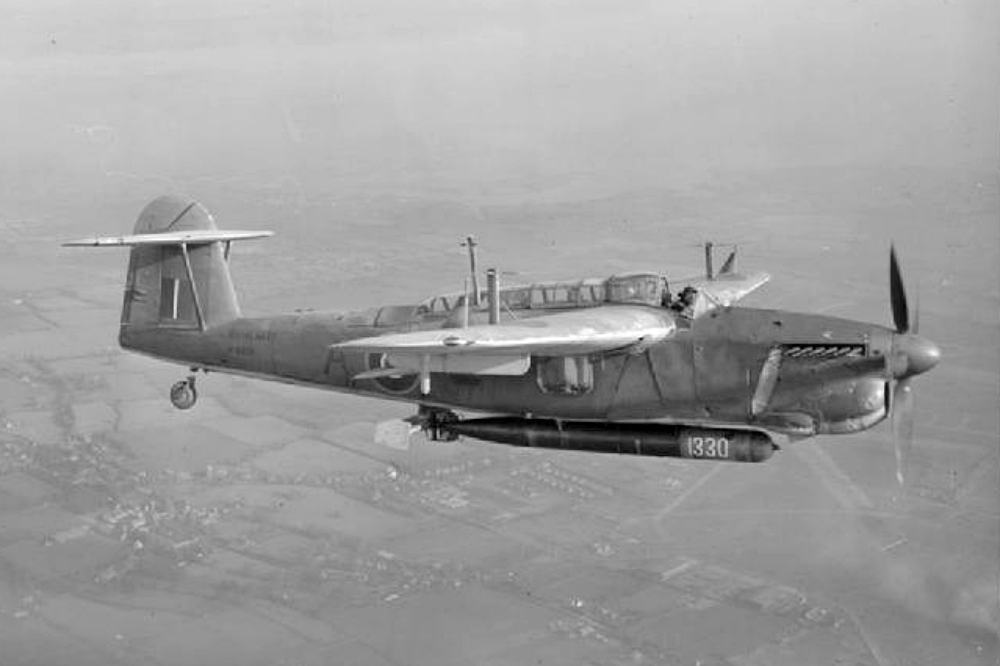According to an interview with RAF pilot Bud Abbott, it was: “A flying abortion.” The Fairy Barracuda was freakishly constructed with high wings, a T-tail, and L-shaped landing gear. It was underpowered and impossible to see out of. Yet here it was, about to take on the mightiest ship that still remained of the German Navy.
Deep in the protective embrace of the Norwegian fjords, towering cliffs, and thick pine forests hid the German Battleship Tirpitz, now deemed the “Lonely Queen of the North” by some and the “Iron Whore” by others.
As the Allies closed in on victory in the spring of 1944, Tirpitz was still one of the biggest threats in the German Navy. Although she was stuck sulking in the Arctic, her mere presence continued to prove a distraction for Allied shipping – to the point that the British decided they had finally had enough.
On the morning of April 3, 1944, the stillness of Tirpitz’s hiding place in the fjord was interrupted by the shattering roar of approaching engines. Before the ship could fully deploy the smoke screen generators, forty Fairey Barracudas appeared— their Rolls-Royce Merlin engines dragging them through the air.
The Barracudas carried a potentially devastating mix of 1,600- and 500-pound bombs. Fully loaded, they were fat, heavy, and slow – barely able to take off from their carriers. Now they were being asked to waddle in and finish the job that proper and more illustrious bombers such as the Halifax and Lancaster had failed to do before…
The Fairey Barracuda was a British carrier-borne torpedo and dive bomber designed by Fairey Aviation. It was the first aircraft of this type operated by the Royal Navy’s Fleet Air Arm (FAA) to be fabricated entirely from metal.
The Barracuda was developed as a replacement for the Fairey Albacore biplanes. Development was protracted due to the original powerplant intended for the type, the Rolls-Royce Exe, being cancelled. It was replaced by the less powerful Rolls-Royce Merlin engine. On 7 December 1940, the first Fairey prototype conducted its maiden flight. Early testing revealed it to be somewhat underpowered. However, the definitive Barracuda Mk II had a more powerful model of the Merlin engine, while later versions were powered by the larger and even more powerful Rolls-Royce Griffon engine.
The type was ordered in bulk to equip the FAA. In addition to Fairey’s own production line, Barracudas were also built by Blackburn Aircraft, Boulton Paul, and Westland Aircraft.

A Royal Navy Fairey Barracuda II (s/n P9926) from Lee-on-Solent Fleet Air Arm Station, Hampshire (UK), with torpedo, in flight. The wooden plane that steadied the torpedo before it struck the water and broke off can be clearly seen at the rear of the weapon. The ASV radar “Yagi” antennae are visible above the wings.
The type participated in numerous carrier operations during the conflict, being deployed in the Atlantic Ocean, Mediterranean Sea, and the Pacific Ocean against the Germans, Italians, and Japanese respectively during the latter half of the war. One of the Barracuda’s most noteworthy engagements was a large-scale attack upon the German battleship Tirpitz on 3 April 1944. In addition to the FAA, the Barracuda was also used by the Royal Air Force, the Royal Canadian Navy, the Dutch Naval Aviation Service and the French Air Force.
After its withdrawal from service during the 1950s, no intact examples of the Barracuda were preserved despite its once-large numbers, although the Fleet Air Arm Museum has ambitions to assemble a full reproduction.
Photo: A Fairey Barracuda II of 814 Squadron, Fleet Air Arm flying over HMS Venerable and an attendant destroyer, the Italian ALFREDO ORIANI.
Sources: Wikipedia; YouTube

